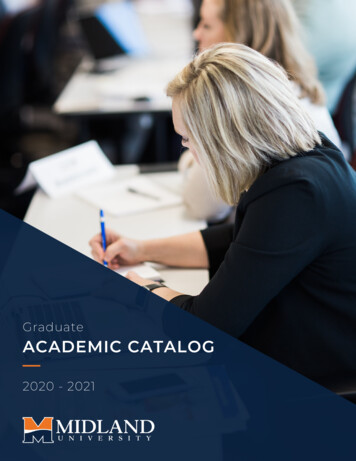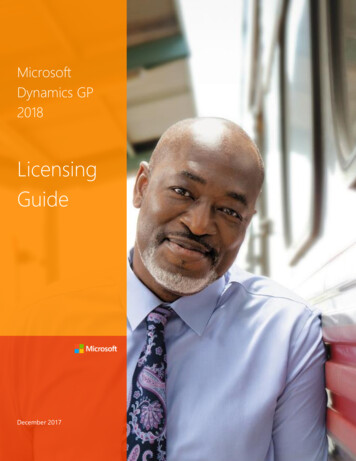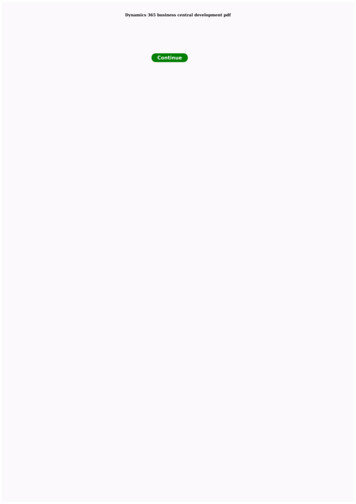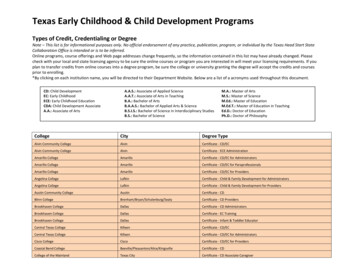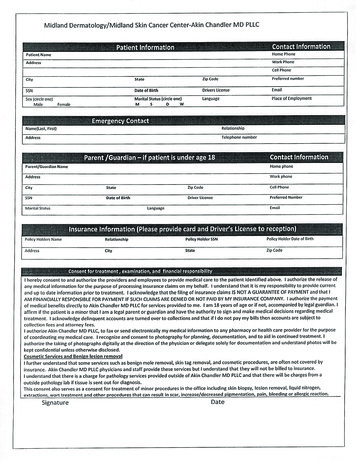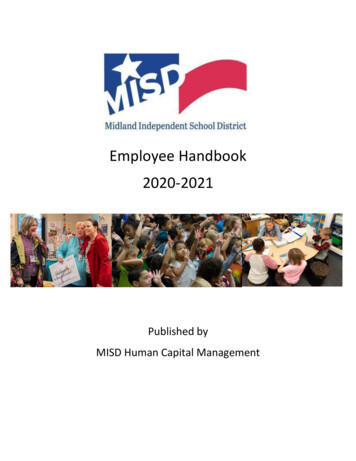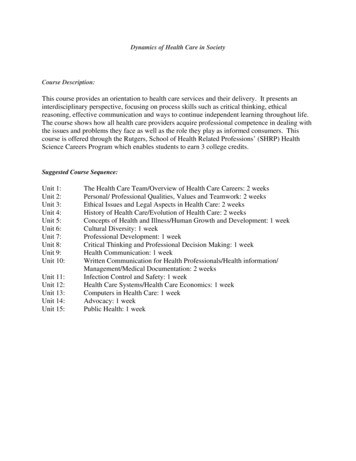
Transcription
Dynamics of Health Care in SocietyCourse Description:This course provides an orientation to health care services and their delivery. It presents aninterdisciplinary perspective, focusing on process skills such as critical thinking, ethicalreasoning, effective communication and ways to continue independent learning throughout life.The course shows how all health care providers acquire professional competence in dealing withthe issues and problems they face as well as the role they play as informed consumers. Thiscourse is offered through the Rutgers, School of Health Related Professions’ (SHRP) HealthScience Careers Program which enables students to earn 3 college credits.Suggested Course Sequence:Unit 1:Unit 2:Unit 3:Unit 4:Unit 5:Unit 6:Unit 7:Unit 8:Unit 9:Unit 10:Unit 11:Unit 12:Unit 13:Unit 14:Unit 15:The Health Care Team/Overview of Health Care Careers: 2 weeksPersonal/ Professional Qualities, Values and Teamwork: 2 weeksEthical Issues and Legal Aspects in Health Care: 2 weeksHistory of Health Care/Evolution of Health Care: 2 weeksConcepts of Health and Illness/Human Growth and Development: 1 weekCultural Diversity: 1 weekProfessional Development: 1 weekCritical Thinking and Professional Decision Making: 1 weekHealth Communication: 1 weekWritten Communication for Health Professionals/Health information/Management/Medical Documentation: 2 weeksInfection Control and Safety: 1 weekHealth Care Systems/Health Care Economics: 1 weekComputers in Health Care: 1 weekAdvocacy: 1 weekPublic Health: 1 week
Unit OverviewContent Area:Dynamics of Health Care in SocietyUnit Title:UNIT 1 ‐ The Health Care Team/Overview of Health Care CareersTarget Course/Grade Level: Grades 11 and 12Unit Summary:Many different professionals, working in the interdisciplinary system has replaced thetraditional hierarchical structure, provide health care services. This unit should help studentsunderstand the roles played by all these team members as they work to deliver comprehensiveand coordinated care.Interdisciplinary Connections:SCIENCE: LS1B Growth & Development of Organisms2.1A Personal Growth & Development2.1C Disease2.2E Health Services2.3A MedicineSOCIAL STUDIES:Similar connections may be made between social studies content areas (6.3) and the following areas ofcontent such as (2.2A) interpersonal communication skills, (2.1E) social, and (2.2E) health services.LANGUAGE ARTS LITERACY:CCSS.ELA‐LITERACY.CCRA.W.4Produce clear and coherent writing in which the development, organization, and style are appropriate totask, purpose, and audience.CCSS.ELA‐LITERACY.CCRA.W.6Use technology, including the Internet, to produce and publish writing and to interact and collaboratewith others.CCSS.ELA‐LITERACY.CCRA.W.8Gather relevant information from multiple print and digital sources, assess the credibility and accuracyof each source, and integrate the information while avoiding plagiarism.CCSS.ELA‐LITERACY.CCRA.W.9Draw evidence from literary or informational texts to support analysis, reflection, and research.CCSS.ELA‐LITERACY.CCRA.W.10Write routinely over extended time frames (time for research, reflection, and revision) and shorter timeframes (a single sitting or a day or two) for a range of tasks, purposes, and audiences.CCSS.MATH PRACTICES1 and 2Make sense of problems and reason abstractly during health data analysis.WIDA English Language Development Standard 1English language learners communicate for social and instructional purposes within the school setting.
21st century themes:Creativity and Innovation, Critical Thinking and Problem Solving,Communication and Collaboration, Information Literacy, Media Literacy,Communication Literacy, and Life and Career SkillsCareer Ready PracticesCRP1. Act as a responsible and contributing citizen and employee.CRP2. Apply appropriate academic and technical skills.CRP3. Attend to personal health and financial well‐being.CRP4. Communicate clearly and effectively and with reason.CRP5. Consider the environmental, social and economic impacts of decisions.CRP6. Demonstrate creativity and innovation.CRP7. Employ valid and reliable research strategies.CRP8. Utilize critical thinking to make sense of problems and persevere insolving them.CRP9. Model integrity, ethical leadership and effective management.CRP10. Plan education and career paths aligned to personal goals.CRP11. Use technology to enhance productivity.CRP12. Work productively in teams while using cultural global competence.Learning TargetsStandards:2.1 Wellness: All students will acquire health promotion concepts and skills to support a healthy,active lifestyle. A. Personal Growth and DevelopmentDeveloping and maintaining wellness requires ongoing evaluation of factors impacting healthand modifying lifestyle behaviors accordingly. C. Diseases and Health ConditionsPersonal health is impacted by family, community, national, and international efforts to preventand control diseases and health conditions. E. Social and Emotional HealthStress management skills impact an individual’s ability to cope with different types of emotionalsituations.2.2 Integrated Skills: All students will develop and use personal and interpersonal skills to support ahealthy, active lifestyle. A. Interpersonal CommunicationEffective interpersonal communication encompasses respect and acceptance for individualsregardless of gender, sexual orientation, disability, ethnicity, socioeconomic background,religion, and/or culture.Technology increases the capacity of individuals to communicate in multiple and diverse ways. C. Character DevelopmentCore ethical values impact behaviors that influence the health and safety of people everywhere. D. Advocacy and ServiceEffective advocacy for a health or social issue is based on communicating accurate and reliableresearch about the issue and developing and implementing strategies to motivate others toaddress the issue.
E. Health Services and InformationPotential solutions to health issues are dependent on health literacy and available resources.Affordability and accessibility of healthcare impacts the prevention, early detection, andtreatment of health problems.8.1 Educational Technology: All students will use digital tools to access, manage, evaluate, andsynthesize information in order to solve problems individually and collaborate and to create andcommunicate knowledge. A. Technology Operations and ConceptsStudents demonstrate a sound understanding of technology concepts, systems and operations C. Communication and CollaborationStudents use digital media and environments to communicate and work collaboratively,including at a distance, to support individual learning and contribute to the learning of others. D. Digital CitizenshipStudents understand human, cultural, and societal issues related to technology and practicelegal and ethical behavior. E. Research and Information FluencyStudents apply digital tools to gather, evaluate, and use information. F. Critical thinking, problem solving, and decision makingStudents use critical thinking skills to plan and conduct research, manage projects, solveproblems, and make informed decisions using appropriate digital tools and resources.CPI 22.2.12.C.32.2.12.D.12.2.12.E.1Cumulative Progress Indicator (CPI)Analyze the role of personal responsibility in maintaining and enhancing personal,family, community, and global wellness.Debate the social and ethical implications of the availability and use of technology andmedical advances to support wellness.Determine diseases and health conditions that may occur during one’s lifespan andidentify prevention and treatment strategies.Develop strategies that will impact local, state, national, and international public healthefforts to prevent and control diseases and health conditions.Develop a personal stress management plan to improve/maintain wellness.Employ skills for communicating with family, peers, and people from other backgroundsand cultures that may impact the health of oneself and others.Demonstrate strategies to prevent, manage, or resolve interpersonal conflicts.Analyze the impact of technology on interpersonal communication in supportingwellness and a healthy lifestyle.Analyze the impact of competition on personal character developmentJudge how individual or group adherence, or lack of adherence, to core ethical valuesimpacts the local, state, national, and worldwide community.Analyze current issues facing the disability community and make recommendations toaddress those issues.Plan and implement an advocacy strategy to stimulate action on a state, national, orglobal health issue, including but not limited to, organ/tissue donation.Analyze a variety of health products and services based on cost, availability,accessibility, benefits, and accreditation.
2.2.12.E.28.1.12.D.3Determine the effect of accessibility and affordability of healthcare on family,community, and global health.Create a personal digital portfolio which reflects personal and academic interests,achievements, and career aspirations by using a variety of digital tools and resources.Produce and edit a multi‐page digital document for a commercial or professionalaudience and present it to peers and/or professionals in that related area for reviewCollaborate in online courses, learning communities, social networks or virtual worldsto discuss a resolution to a problem or issue.Construct a spreadsheet workbook with multiple worksheets, rename tabs to reflectthe data on the worksheet, and use mathematical or logical functions, charts and datafrom all worksheets to convey the results.Create a report from a relational database consisting of at least two tables and describethe process, and explain the report results.Develop an innovative solution to a real world problem or issue in collaboration withpeers and experts, and present ideas for feedback through social media or in an onlinecommunity.Demonstrate appropriate application of copyright, fair use and/or Creative Commons toan original work.Evaluate consequences of unauthorized electronic access (e.g., hacking) and disclosure,and on dissemination of personal information.Compare and contrast policies on filtering and censorship both locally and globally.8.1.12.D.4Research and understand the positive and negative impact of one’s digital footprint.8.1.12.D.5Analyze the capabilities and limitations of current and emerging technology resourcesand assess their potential to address personal, social, lifelong learning, and careerneeds.Produce a position statement about a real world problem by developing a systematicplan of investigation with peers and experts synthesizing information from multiplesources.Evaluate the strengths and limitations of emerging technologies and their impact oneducational, career, personal and or social 12.F.1Unit Essential Questions What are the different types of health carefacilities? How do licensed health care professionalspractice? What is registration for health careprofessionals? What is certification for health careprofessionals? What do medical assistants do? What is a surgical technologist? What does a physician assistant do? What do EMTs and Paramedics do?Unit Enduring Understandings Health care facilities include hospitals,subacute care, extended care, rehabilitationcenters, mental health facilities, and hospice. Licensed health care professionals mustpractice their professions according to theguidelines and limitations set by the state inwhich they are licensed. Registration means that a health careprofessional has graduated from an accreditedschool and has passed a standardized nationalexam. Certification is awarded by professional
What are the differences between and RN,an LPN, and a CNA?What are the differences between aDentist and a Dental Hygienist?What is a Clinical Laboratory Technologist?What is a Laboratory Assistant?What is the difference between aPharmacist and a Pharmacy Technician?What are the health careers available inDiagnostic and Imaging Services?What are the health careers in Therapyand Rehabilitation? organizations.Medical assistants perform administrative andclinical tasks to keep medical offices runningsmoothly.A surgical technologist performs tasks before,during, and after operations.A physician assistant examines patients,diagnoses illnesses, arranges treatment, andperforms other tasks under the supervision ofa doctor.EMTs and Paramedics provide emergencymedical treatment for critically ill and injuredpeople at the scene of accidents and otherlocations.An RN is a Registered Nurse, an LPN is aLicensed Practical Nurse, and a CAN is aCertified Nursing Assistant.A Dentist cares for people’s teeth and gumsand a Dental Hygienist clean and polish teeth.A Clinical Laboratory Technologist preparesspecimens, performs tests on them, checksthe results, and interprets results.A Laboratory Assistant provides a variety ofclinical and administrative support services.A Pharmacist is authorized by law to dispenseprescription medication and a PharmacyTechnician helps Pharmacists fill prescriptions,and do administrative work.Diagnostic and Imaging careers includeCardiographic Technicians, Phlebotomists,Diagnostic Medical Sonographers, RadiologicTechnicians, and Nuclear MedicineTechnologists.Therapy and Rehabilitation careers includePhysical Therapy, Occupational Therapy,Respiratory Therapy, and Massage Therapy.Unit Learning TargetsStudents will Define the mission of the health related professions and the health care team. They will understandthe scope of this mission and its underlying concepts. Identify a minimum of fifteen (15) health care professionals (HCPs) by describing how each helps inproviding care. Describe the educational requirements for Associate, Baccalaureate, Master’s and Doctoral degreelevel preparation for specific professions. Describe the difference between certification, registration and licensure for professional practice. Compare the fifteen HCPs referred to in #2 by describing basic activities performed in each, listing
their specific duties, explaining their educational prerequisites, and reporting on currentemployment opportunities.Distinguish between hierarchal and team health systems.Identify and describe the major health facilities.Identify and describe the major trends that influence health care.Explain how effective communication and mutual respect contribute to optimum functioning of aninterdisciplinary health care services team.Evidence of LearningSummative Assessment (X days) – 10 daysTestsReview QuestionsInvestigate It Questions at the end of each chapterProjectsEquipmentTextbooks, Interwrite Board, LaptopsNeeded:Teacher Resources: Textbooks and Dynamics of Health Care Teaching CompanionFormative Assessments Teacher observation Class work Written responses “Investigate It” responses Class DiscussionModifications:Special Education StudentsAllow errorsRephrase questions, directions, and explanationsAllow extended time to answer questions, andpermit drawing, as an explanationAccept participation at any level, even one wordConsult with Case Managers and follow IEPaccommodations/modificationsEnglish Language LearnersAssign a buddy, same language or English speakingAllow errors in speakingRephrase questions, directions, and explanationsAllow extended time to answer questions, andpermit drawing, as an explanationAccept participation at any level, even one wordAt‐Risk StudentsProvide extended time to complete tasksConsult with Guidance Counselors and follow I&RSprocedures/action plansConsult with classroom teacher(s) for specificbehavior interventionsProvide rewards as necessary
Gifted and Talented StudentsProvide extension activitiesBuild on students’ intrinsic motivationsConsult with parents to accommodate students’interests in completing tasks at their level ofengagementLesson #1Lesson NameToday’s Health CareSystem and Overview ofHealth care Careers2Medical and SurgicalCareers3Dental, Laboratory, andPharmacy Services.4Diagnostic and ImagingCareers5Therapy andRehabilitation CareersTeacher Notes:Lesson PlansTime frame (hours/days)2 days2 days2 days2 days2 daysCurriculum Development ResourcesClick links below to access additional resources used to design this unit:Required TextbookDeLaet, Roxann. Dynamics of Health Care in Society, Lippincott, Williams & Wilkins, Wolters, Kluwer,2012, Revised EditionISBN of 978‐1‐4511‐8977‐3.Diversified Health OccupationsL. SimmersDelmar Publishers, INCIt’s A Jungle Out There: An Insider’s Outlook on Jobs in Health CareersSherry Mackely, Ph.D. RTRLana Christianson, MT, MA, CRCPine Ridge Publications, (812) 876‐72111051 West Burma Rd.Bloomington, Indiana 47404Health Politics and PolicyThird EditionTheodor J. LitmanLeonard S. Robins
Delmar, Publishers, Inc.Medical Law and EthicsMichael LipmanRegents/ Prentice HallEnglewood Cliffs, NJ 07632The Resume Catalog200 Damn Good ExamplesYana ParkerTen Spees PressP.O. Box 7123Berkeley, California 94707A Hospital Handbook in Multi‐Culturalism and ReligionNevill A. KirkwoodGriffen PaperbacksAustraliaCaring For Patients From Different CulturesGeri‐Ann GalantiUniversity of Pennsylvania PressPhiladelphia., Pa.
Unit OverviewContent Area:Dynamics of Health Care in SocietyUnit Title:UNIT 10 ‐ Written Communication for Health Professionals/Health informationManagement/Medical DocumentationTarget Course/Grade Level: Grades 11 and 12Unit Summary:Communication, defined as an exchange of information, is important throughout the healthcare system. Communication involves assessment, diagnosis, treatment, and/ordocumentation. Precision and confidentiality are imperative in all aspects of health carecommunications. Working with medical documents is one of the most important tasks for anyhealth care professional. Good medical documentation is essential to the smooth operation ofany medical facility.Interdisciplinary Connections:SCIENCE: LS1B Growth & Development of Organisms2.1A Personal Growth & Development2.1C Disease2.2E Health Services2.3A MedicineSOCIAL STUDIES:Similar connections may be made between social studies content areas (6.3) and the following areas ofcontent such as (2.2A) interpersonal communication skills, (2.1E) social, and (2.2E) health services.LANGUAGE ARTS LITERACY:CCSS.ELA‐LITERACY.CCRA.W.4Produce clear and coherent writing in which the development, organization, and style are appropriate totask, purpose, and audience.CCSS.ELA‐LITERACY.CCRA.W.6Use technology, including the Internet, to produce and publish writing and to interact and collaboratewith others.CCSS.ELA‐LITERACY.CCRA.W.8Gather relevant information from multiple print and digital sources, assess the credibility and accuracyof each source, and integrate the information while avoiding plagiarism.CCSS.ELA‐LITERACY.CCRA.W.9Draw evidence from literary or informational texts to support analysis, reflection, and research.CCSS.ELA‐LITERACY.CCRA.W.10Write routinely over extended time frames (time for research, reflection, and revision) and shorter timeframes (a single sitting or a day or two) for a range of tasks, purposes, and audiences.CCSS.MATH PRACTICES1 and 2Make sense of problems and reason abstractly during health data analysis.
WIDA English Language Development Standard 1English language learners communicate for social and instructional purposes within the school setting.21st century themes:Creativity and Innovation, Critical Thinking and Problem Solving,Communication and Collaboration, Information Literacy, Media Literacy,Communication Literacy, and Life and Career SkillsCareer Ready PracticesCRP1. Act as a responsible and contributing citizen and employee.CRP2. Apply appropriate academic and technical skills.CRP3. Attend to personal health and financial well‐being.CRP4. Communicate clearly and effectively and with reason.CRP5. Consider the environmental, social and economic impacts of decisions.CRP6. Demonstrate creativity and innovation.CRP7. Employ valid and reliable research strategies.CRP8. Utilize critical thinking to make sense of problems and persevere insolving them.CRP9. Model integrity, ethical leadership and effective management.CRP10. Plan education and career paths aligned to personal goals.CRP11. Use technology to enhance productivity.CRP12. Work productively in teams while using cultural global competence.Learning TargetsStandards:2.1 Wellness: All students will acquire health promotion concepts and skills to support a healthy,active lifestyle. A. Personal Growth and DevelopmentDeveloping and maintaining wellness requires ongoing evaluation of factors impacting healthand modifying lifestyle behaviors accordingly. C. Diseases and Health ConditionsPersonal health is impacted by family, community, national, and international efforts to preventand control diseases and health conditions. E. Social and Emotional HealthStress management skills impact an individual’s ability to cope with different types of emotionalsituations.2.2 Integrated Skills: All students will develop and use personal and interpersonal skills to support ahealthy, active lifestyle. A. Interpersonal CommunicationEffective interpersonal communication encompasses respect and acceptance for individualsregardless of gender, sexual orientation, disability, ethnicity, socioeconomic background,religion, and/or culture.Technology increases the capacity of individuals to communicate in multiple and diverse ways. C. Character DevelopmentCore ethical values impact behaviors that influence the health and safety of people everywhere. D. Advocacy and Service
Effective advocacy for a health or social issue is based on communicating accurate and reliableresearch about the issue and developing and implementing strategies to motivate others toaddress the issue. E. Health Services and InformationPotential solutions to health issues are dependent on health literacy and available resources.Affordability and accessibility of healthcare impacts the prevention, early detection, andtreatment of health problems.8.1 Educational Technology: All students will use digital tools to access, manage, evaluate, andsynthesize information in order to solve problems individually and collaborate and to create andcommunicate knowledge. A. Technology Operations and ConceptsStudents demonstrate a sound understanding of technology concepts, systems and operations C. Communication and CollaborationStudents use digital media and environments to communicate and work collaboratively,including at a distance, to support individual learning and contribute to the learning of others. D. Digital CitizenshipStudents understand human, cultural, and societal issues related to technology and practicelegal and ethical behavior. E. Research and Information FluencyStudents apply digital tools to gather, evaluate, and use information. F. Critical thinking, problem solving, and decision makingStudents use critical thinking skills to plan and conduct research, manage projects, solveproblems, and make informed decisions using appropriate digital tools and resources.CPI 22.2.12.C.32.2.12.D.1Cumulative Progress Indicator (CPI)Analyze the role of personal responsibility in maintaining and enhancing personal,family, community, and global wellness.Debate the social and ethical implications of the availability and use of technology andmedical advances to support wellness.Determine diseases and health conditions that may occur during one’s lifespan andidentify prevention and treatment strategies.Develop strategies that will impact local, state, national, and international public healthefforts to prevent and control diseases and health conditions.Develop a personal stress management plan to improve/maintain wellness.Employ skills for communicating with family, peers, and people from other backgroundsand cultures that may impact the health of oneself and others.Demonstrate strategies to prevent, manage, or resolve interpersonal conflicts.Analyze the impact of technology on interpersonal communication in supportingwellness and a healthy lifestyle.Analyze the impact of competition on personal character developmentJudge how individual or group adherence, or lack of adherence, to core ethical valuesimpacts the local, state, national, and worldwide community.Analyze current issues facing the disability community and make recommendations toaddress those issues.Plan and implement an advocacy strategy to stimulate action on a state, national, orglobal health issue, including but not limited to, organ/tissue donation.
2.2.12.E.18.1.12.D.3Analyze a variety of health products and services based on cost, availability,accessibility, benefits, and accreditation.Determine the effect of accessibility and affordability of healthcare on family,community, and global health.Create a personal digital portfolio which reflects personal and academic interests,achievements, and career aspirations by using a variety of digital tools and resources.Produce and edit a multi‐page digital document for a commercial or professionalaudience and present it to peers and/or professionals in that related area for reviewCollaborate in online courses, learning communities, social networks or virtual worldsto discuss a resolution to a problem or issue.Construct a spreadsheet workbook with multiple worksheets, rename tabs to reflectthe data on the worksheet, and use mathematical or logical functions, charts and datafrom all worksheets to convey the results.Create a report from a relational database consisting of at least two tables and describethe process, and explain the report results.Develop an innovative solution to a real world problem or issue in collaboration withpeers and experts, and present ideas for feedback through social media or in an onlinecommunity.Demonstrate appropriate application of copyright, fair use and/or Creative Commonsto an original work.Evaluate consequences of unauthorized electronic access (e.g., hacking) and disclosure,and on dissemination of personal information.Compare and contrast policies on filtering and censorship both locally and globally.8.1.12.D.4Research and understand the positive and negative impact of one’s digital 8.1.12.D.5Analyze the capabilities and limitations of current and emerging technology resourcesand assess their potential to address personal, social, lifelong learning, and careerneeds.8.1.12.E.1Produce a position statement about a real world problem by developing a systematicplan of investigation with peers and experts synthesizing information from multiplesources.8.1.12.F.1Evaluate the strengths and limitations of emerging technologies and their impact oneducational, career, personal and or social needs.Unit Enduring UnderstandingsUnit Essential Questions Medical documentation serves many What is the importance of medicalpurposes, including communication,documentation?assessment,quality assurance, What do medical records include?reimbursement, legal record, education, and What is the definition of good medicalresearchdocumentation? Medical records include an admission sheet, What do progress notes document?graphic sheet, physician’s orders, progressnotes, medical history and examinationsheet, reports, correspondence, and otherdocuments. Good medical documentation is accurate,complete, concise, legible, and organized.
Progress notes documents each contactmade between a health care professionaland the patient.Unit Learning TargetsStudents will Explain how important writing is in transmitting ideas and instructions. Give examples of clear, direct writing. Explain what Roger Angell meant, in his introduction to his step‐father’s great book, The Elements ofStyle, “ We are all writers and readers as well as communicators, with the need to please andsatisfy ourselves (as White put it) with the clear and almost perfect thought.” Show how a piece of writing improves in style and clarity as it is revised and revised and revised overand over again. Analyze the work of others. Analyze and criticize examples of health related writing posted on the web. Understand what Will Strunk was talking about when he urged writers to “Omit needless words!” Understand the difference between the active and the passive voice and know why it is almostalways better to use the active voice.Evidence of LearningSummative Assessment (X days) – 10 daysTestsReview QuestionsInvestigate It Questions at the end of each chapterProjectsEquipment Needed:Textbooks, Interwrite Board, LaptopsTeacher Resources:Textbooks and Dynamics of Health Care Teaching CompanionFormative Assessments Teacher observation Class work Written responses “Investigate It” responses Class DiscussionModifications:Special Education StudentsAllow errorsRephrase questions, directions, and explanationsAllow extended time to answer questions, andpermit drawing, as an explanationAccept participation at any level, even one wordConsult with Case Managers and follow IEPaccommodations/modificationsEnglish Language LearnersAssign a buddy, same language or English speakingAllow errors in speaking
Rephrase questions, directions, and explanationsAllow extended time to answer questions, andpermit drawing, as an explanationAccept participation at any level, even one wordAt‐Risk StudentsProvide extended time to complete tasksConsult with Guidance Counselors and follow I&RSprocedures/action plansConsult with classroom teacher(s) for specificbehavior interventionsProvide rewards as necessaryGifted and Talented StudentsProvide extension activitiesBuild on students’ intrinsic motiv
Unit Overview Content Area: Dynamics of Health Care in Society Unit Title: UNIT 1 ‐ The Health Care Team/Overview of Health Care Careers Target Course/Grade Level: Grades 11 and 12 Unit Summary: Many different professionals, working in the interdisciplinary system has replaced the


